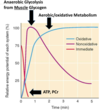Bone Metabolism/Homeostasis Flashcards
Skeletal muscle cells are mostly packed with?
-
Myofibrils
- bulk of cytoplasm is myofibrils ( contractile elements)
- Myofibrils in skeletal muscle cells are made of?
- How do these interact to produce contraction?
-
Actin and myosin
- Myosin head has ATP binding site and ATPase activity
- ATP binding and hydrolysis change the conformation of myosin allowing its head to cyclically associate/dissociate from actin
- resulting in forward sliding actin filament
Power physical performance that is short (few seconds), is supported by which energy sources?
- ATP and Creatine phosphate (Phosphocreatine; PCr)
- Immediate energy source
Speed/ spurts of activity that last several seconds to a minute use which type of energy source?
- ATP generated from rapid anaerobic/ nonoxidative glycolysis of local muscle gylcogen

Endurance activity (>2 minutes) is supported by which energy source?
- ATP from fat oxidation (adipose) and liver glycogen
- What is the most abundant and immediate source of ATP in skeletal muscle cells?
- Why are ATP stores so small is muscle?
- Creatine phosphate (have high energy P bonds)
- ATP is low because many reactions are allosterically activated/inhibited by ATP
- ([] is under very tight control)
Reaction from creatine to creatine phosphate is reversible or irreversible?
Reversible (CPK) cells can rapidly recuperate stored energy
In power performance, as muscle cells rapidly regenerate ATP from PCr and ADP what builds up?
- AMP accumulates and Myokinase generates ATP from ADP
- Now, AMP accumulates and allosterically activates enzymes (in later steps for energy)
In absence of O2 what happens to pyruvate?
- remains in cytosol and is converted to lactate to produce NAD+
- keeps anaerobic glycolysis going
In the presence of O2 what happens to pyruvate?
Pyruvate DH links glycolysis to the citric acid cycle
Where does anaerobic glycolysis use glucose from to quickly meet the increased energy needs?
local muscle glycogen
T/F: anaerobic glycolysis provides rapid but self limited source of ATP
- True
- It has low ATP yield (2 ATP per Glc) and thus muscle rapidly decreases its glycogen stores
- < 2 minutes
- How long does it take for the exercise- stimulated increase in blood flow to arrive to muscles?
- What does the blood bring with it?
- Takes >1 min blood flow
- brings:
- O2, glucose and FA
- aerobic glycolysis and oxidative phosphorylation to begin
- O2, glucose and FA
Exercise activates__ and ___ simultaneously
-
Glycogenolysis and Glycolysis
- As muscle begins to contract and hydrolyze ATP to ADP, myokinase converts ADP to ATP and AMP accumulates
- AMP binds and allosterically activates key enzymes of glycogen breakdown (muscle phosphorylase B) and glycolysis (PFK-1 )
What two enzymes does increase in AMP activate in glycolysis and glycogenolysis?
- muscle phosphorylase b (glycogen breakdown)
- PFK-1 (glycolysis)
What are the two reasons that anaerobic generation of ATP is self limiting?
- Inefficient:
- anaerobic generation of ATP from muscle glycogen captures only a fraction of energy stored in glucose (2 ATP)
- Lactate causes acidosis as H+ accumulate



